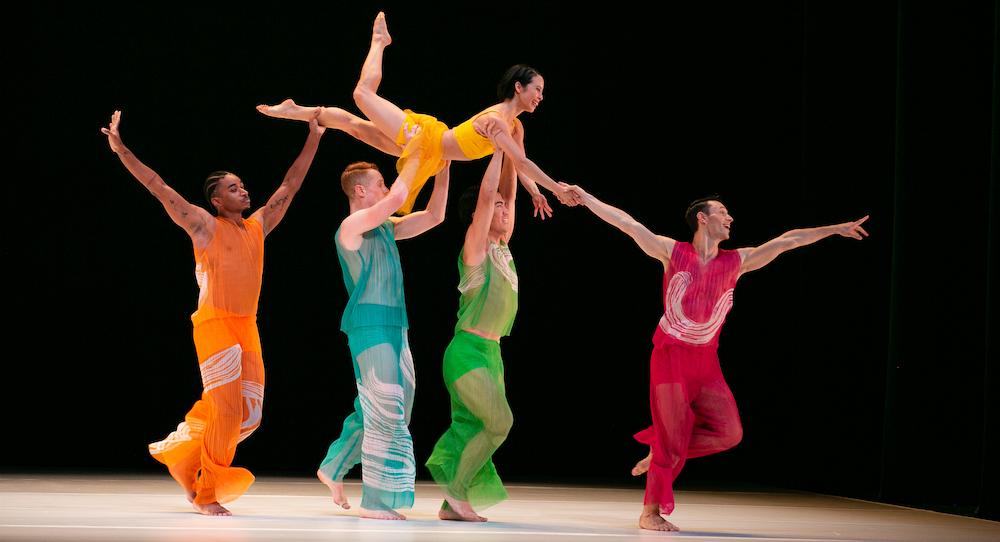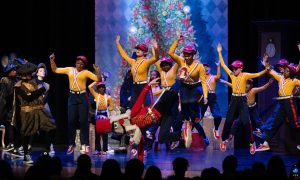Shubert Theater, Boston, MA.
April 16, 2023.
Paul Taylor is undeniably a giant in classic American modern dance. His work has inspired generations of choreographers, dancers and enthusiasts alike. Yet, can that work also open a window into history itself? Is the art of the moving body uniquely positioned to tell the stories of the past? Can that lead us to better understanding of who and where we are, and even who we’ll be and where we’ll go?
These are by no means simple questions – and I was chewing on them with relish after taking in a Paul Taylor Dance Company program through Celebrity Series of Boston, the New York City-based company’s visit to “Beantown” each year.
The program opener, Amy Hall Garner’s Somewhere in the Middle (2022), was a party of a dance piece — electrically colorful and viscerally vibrant. A jazzy overture began the piece (scores for the work from Count Basie, Sarah Vaughan, Duke Ellington and Bill Evans), setting a tone for that atmosphere. The curtain soon rose to reveal massive hanging shapes, of bright hues and unconventional shapes (set by Donald Martiny) – the next ingredient for the jazzy dance party to come.
The ensemble gradually built, wearing costumes matching the palette of the overhead set pieces — halfway between pastels and neons, in everything from yellow to magenta to teal (costumes by Mark Eric). The movement was just as fresh and vivacious, as the vehicle for the personas in the piece to meet, mingle and have a blast. Hall Garner’s movement vocabulary blended a foundation of jazz dance vocabulary with the integration and spinal ooziness of contemporary dance.
Unison sections had quite clean timing and staging – yet, there was also a casuality and looseness to these sections, that which reflected jazz improvisation: artists expressing individuality through unique choices, and also moving in harmony with the energy and structure of the group’s choices. That’s a riveting tension that pulls people toward the art form of jazz music, and – I’d argue – also toward dance.
I also felt a holding of supportive space within that tension — the ensemble members encouraging one another in those uniquely expressive choices. Bold lifts embodied this sense of support. Nothing stayed stagnant, either; the overhead set pieces, groups of dancers and songs all shifted. A soloist ate up the stage just as much as the whole ensemble did, and a more reflective, somber section offered an effective change of tone. Nothing stale, nothing that overstayed its welcome – only that which riveted.
Thinking about all of that, it hit me that Hall Garner’s work was a great fit to pair with Taylor’s work, offering similar musical affinity, pure ebullience and kinetic intricacy – all in service of creating joy and light in motion. None of that is a waste of time or space, and dance art like this is an Exhibit A of that truth. This piece also offered a window into an iconic world, one which has captivated imaginations and staked its claim in culture: a jazz nightclub of the mid-20th century. It was a look into the past, through the lens of the dynamic dance of now.
Taylor’s Brandenburgs (1988) turned that lens toward something quite different in tone — something much more traditional and stately. There was something quite Esplanade (1975) to its effervescent blend of pedestrian and technical movement, of circular patterns across the stage. In both works, the poet of dance that was Taylor thoughtfully assembled basic movement ingredients (hops, skips, runs) to craft something much more than the sum of its parts. With dashes of more athletic leaps, turns and layered movement phrases, the dish was complete – and quite satisfying.
Yet, this work’s ceremonial, processional tone was something quite different than that of Taylor’s eponymous Esplanade. Sections of some dancers witnessing other dancers move – in stillness, just absorbing – spoke to self-presentation. Diagonal lines and morphing, evolving circles reflected ritual. Carefully shaped and placed port de bras (“carriage of the arms”, in dance speak) reminisced the wings of a graceful bird in flight.
Costumes of velvet earth tones (costumes by Santo Loquasto) and the sweeping, swelling orchestral score (movements from Bach’s Brandenberg Concertos) seemed to also be fundamental in creating this ceremonial atmosphere – impressing upon me just what a big impact those design choices can make. Also not lost on me was the significance of dancers who bring pure heart and commitment to their performance – furthermore, love and reverence, the kind which it seems Taylor also brought to his part in the work.
With all of these strong, evocative pieces in place, I saw in this work a hat tip to concert dance’s very roots: European courts where personal politics reigned supreme, and the ability to dance well could mean a step up the social ladder (and, less fortunately, vice-versa). An ending tableau crystalized those moments so opulent and grand that it seems time stands still. Absent such a contextual lens, what a multi-sensory treat this piece was – and that’s also more than enough.
The program closer, Taylor’s Company B, had the most overt historical element in the program – and the vivacity of it all, as well. Once again, 1940’s style costumes (also by Santo Loquasto) and big band swing music (by the Andrews Sisters) were key in setting that context. It was clear to me that Taylor was a master of movement – both at the individual body and group levels – and of building worlds onstage.
For this work, Taylor harmoniously married swing dance vocabulary with modern dance elements – such as lifts with luscious long lines – to both clarify an aesthetic and stay true to that world he was building. That world was one of a country at war but doing its best to let joy ring on despite. In joyfulness can be exciting unpredictability, openness to possibility – and this piece certainly reflected that.
Solos moved into sections of dancers crowding around one ensemble member to witness and cheer on, filled with jest and mirth. One dancer even vocalized “phewie!” at the end of a section – very 1940s, indeed! In that dramatized, even comedic atmosphere, the virtuosity at hand was not one of soaring leaps or kicks pointing right up to sky (although these dancers could undoubtedly deliver that, if called to) – rather, it was one of bringing ease and cheerful groove to the vocabulary at hand. Here, Taylor portrayed true humans who dance, and the ensemble brought that to full life onstage.
Supporting that humanization was Taylor’s building of narrative through movement and structure – separate from his approach in many of his most iconic pieces (again, Esplanade, for example), but quite effective nonetheless. From dancers gathering around to hear tell of an island nation in the Pacific Theater, to the namesake “Boogie Woogie Bugle Boy of Company B” strutting his stuff, Taylor told these stories of that nation at war doing its best to not lose its joy.
More than facts or figures, names or dates, this is the history that can call truly call our hearts – that can help us to understand the present as it is and to build a better future. From the most expansive leap to the smallest reach, dance can say the unspoken in these stories of years past – and therein illuminate more than words ever could. For an exemplary illustration of that, and simply a wonderful afternoon of dance, thank you to Paul Taylor Dance Company for bringing your magic to Boston. We can’t wait to experience it again next time.
By Kathryn Boland of Dance Informa.















